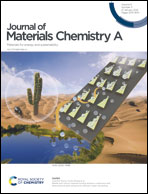Nitrogen reduction through confined electro-catalysis with carbon nanotube inserted metal–organic frameworks†
Abstract
Carbon-based nanomaterials are widely used in electro-catalysis because of their low cost, high conductivity and stability. However, their application towards selective electrochemical reduction of nitrogen to ammonia suffers from low activity and faradaic efficiency (FE). Here, we report a confined electrocatalysis strategy for enhanced ammonia production and FE in the electrochemical nitrogen reduction reaction (eNRR), by the construction of a carbon nanotube (CNT or NCNT) inserted porous metal–organic framework (MOF). The CNT/NCNT serves as the catalytic center and ensures an efficient pathway for electron conduction that is essential to electrocatalysis, while the general relative hydrophobicity within the MOF enriches the local concentration of N2 near the catalyst active sites, and more importantly suppresses the hydrogen evolution reaction (HER) to facilitate the FE. Among the systematically screened MOF and carbon nanotubes, NCNT@MIL-101(Fe) demonstrates the highest activity of 607.35 μg h−1 mgNCNT−1 and CNT@MIL-101(Fe) achieves the best FE of 37.28%. The significantly improved NRR performance of CNT@MOFs and NCNT@MOFs demonstrates the successful employment of confined catalysis in electrochemical reactions, which provides an alternative strategy for catalyst design in nitrogen fixation.



 Please wait while we load your content...
Please wait while we load your content...